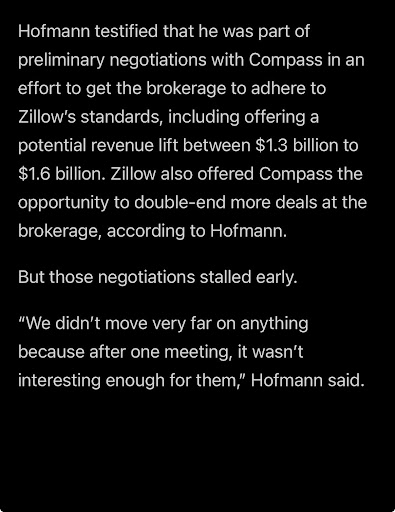 Zillow’s internal strategy materials presented in the Compass litigation show how the company plans to protect its position if Clear Cooperation weakens. Zillow has developed a coordinated plan built on leverage, incentives, and pressure. It also predicts how small, mid, and large brokerages will behave in a fragmented listing environment. It may come as no surprise to anyone that Zillow offered Compass $1.3 billion to $1.6 billion with the ability to double side deals to convince Compass to offer their private exclusives to Zillow exclusively. Compass turned it down. We are not certain if other national brokers accepted these offers or turned them down, but a number of national brokerages have been very outspoken in support of Zillow.
Zillow’s internal strategy materials presented in the Compass litigation show how the company plans to protect its position if Clear Cooperation weakens. Zillow has developed a coordinated plan built on leverage, incentives, and pressure. It also predicts how small, mid, and large brokerages will behave in a fragmented listing environment. It may come as no surprise to anyone that Zillow offered Compass $1.3 billion to $1.6 billion with the ability to double side deals to convince Compass to offer their private exclusives to Zillow exclusively. Compass turned it down. We are not certain if other national brokers accepted these offers or turned them down, but a number of national brokerages have been very outspoken in support of Zillow.
Below is a combined view of Zillow’s pressure tactics, broker reactions Zillow anticipates, and the countermeasures brokers can put in place now. All references sourced from case files.
The core pressure tactics Zillow plans to use:
Zillow’s strategy identifies seven ways it can influence broker behavior when listing data becomes uneven, delayed, or incomplete. Many of these tactics are designed to pit the agent against their brokerage.
-
Limit listing visibility
Zillow can slow ingestion, reduce ranking, or delay display for brokers who withhold early or complete data. Lower visibility reduces leads and creates internal pressure from agents.
Broker countermeasure: build a direct-to-consumer channel using your website, email marketing, and social retargeting so listing exposure is not dependent on third-party ranking. -
Withhold access to Zillow products
Zillow can remove access to Coming Soon, Featured Listing tools, and other promotional features.
Broker countermeasure: invest in your own listing launch system. A consistent, branded, in-house launch process protects agent value even if third-party tools are withdrawn. -
Remove listings
The strategy includes pulling listings from noncooperative brokerages.
Broker countermeasure: strengthen your relationship with the MLS and confirm clear procedures for compliance, syndication settings, IDX feeds, and VOW rules. Ensure you have a dependable path to consumer visibility that Zillow cannot remove. -
Redirect leads
Zillow can increase lead flow to compliant brokers and reduce leads to others.
Broker countermeasure: convert your CRM into a lead generation engine. Enhance lead capture on your site, upgrade forms, improve speed to lead, and promote Homeowner.ai or other owned funnels that keep you in control of relationships. -
Give competitive advantages only to cooperative brokers
Priority ingestion, faster media display, and early access to new tools can be granted to select brokers.
Broker countermeasure: shift your value story away from dependence on third-party features. Showcase internal tools, marketing capabilities, and agent services you control fully. -
Bypass the brokerage
Zillow can appeal directly to agents with listing intake tools and pre-MLS upload paths.
Broker countermeasure: reinforce your value proposition to agents with clear listing intake workflows, strong compliance support, and marketing programs that outperform any external upload path. -
Apply narrative pressure
Zillow can position itself as the platform protecting consumer transparency.
Broker countermeasure: communicate proactively with clients about the role of the MLS, the value of fair display, and your commitment to complete and timely exposure.
How Zillow expects different brokers to react
Large brokerages
Zillow expects national firms to test the limits of listing timing, use internal networks, and promote inventory first to their own agents and clients.
Mid-sized brokerages
Zillow expects these firms to mirror large broker behavior in smaller ways. Selective coming-soon strategies and limited private marketing are expected.
Small brokerages
Zillow expects small firms to rely on the MLS, avoid private networks, and support strong cooperation rules.

https://www.wavgroup.com/product/leveling-the-playing-field/
What brokers can put in place today
Upgrade your listing launch
Create a standard launch kit that every agent can use. Include a story-based presentation, property narrative templates, media checklists, and a coming-soon plan tied to your owned channels. Read our white paper on this topic.
Install a private but compliant buyer-matching system
Use your database to alert buyers before a listing hits Zillow, while staying within MLS rules. Make it simple for agents to match active clients with upcoming listings. (percy.ai or similar tools)
Reduce dependency on third-party portals
The goal is not to abandon portals but to prevent reliance. Shift the primary consumer experience to your own brand so portals become supplemental, not foundational. More importantly, support the Broker Public Portal – Cribio.com – encourage your MLS to participate.
Reinforce the agent value story
Agents are the first target of any platform that wants upstream access to listings. Give them tools you control. Highlight your support, compliance protection, and marketing reach. Make it clear that cooperation strengthens their business. Agents who rely on Zillow tools instead of brokerage tools could face disruption if Zillow leverages products.
The combined implication
Zillow expects large brokers to increase pressure on the MLS by creating more private pathways. Zillow also expects mid-sized firms to follow and small firms to cling to the MLS for fairness. At the same time, Zillow is preparing to use its own levers to ensure listing completeness, even if the industry shifts toward fragmented distribution.
The practical path forward is to reduce reliance on platforms you cannot control. Brokers that reinforce MLS partnership, invest in owned channels, and upgrade listing launch systems can blunt the impact of any visibility or tool-based pressure from external players.
Zillow has not enacted these strategies, but they have a plan.




